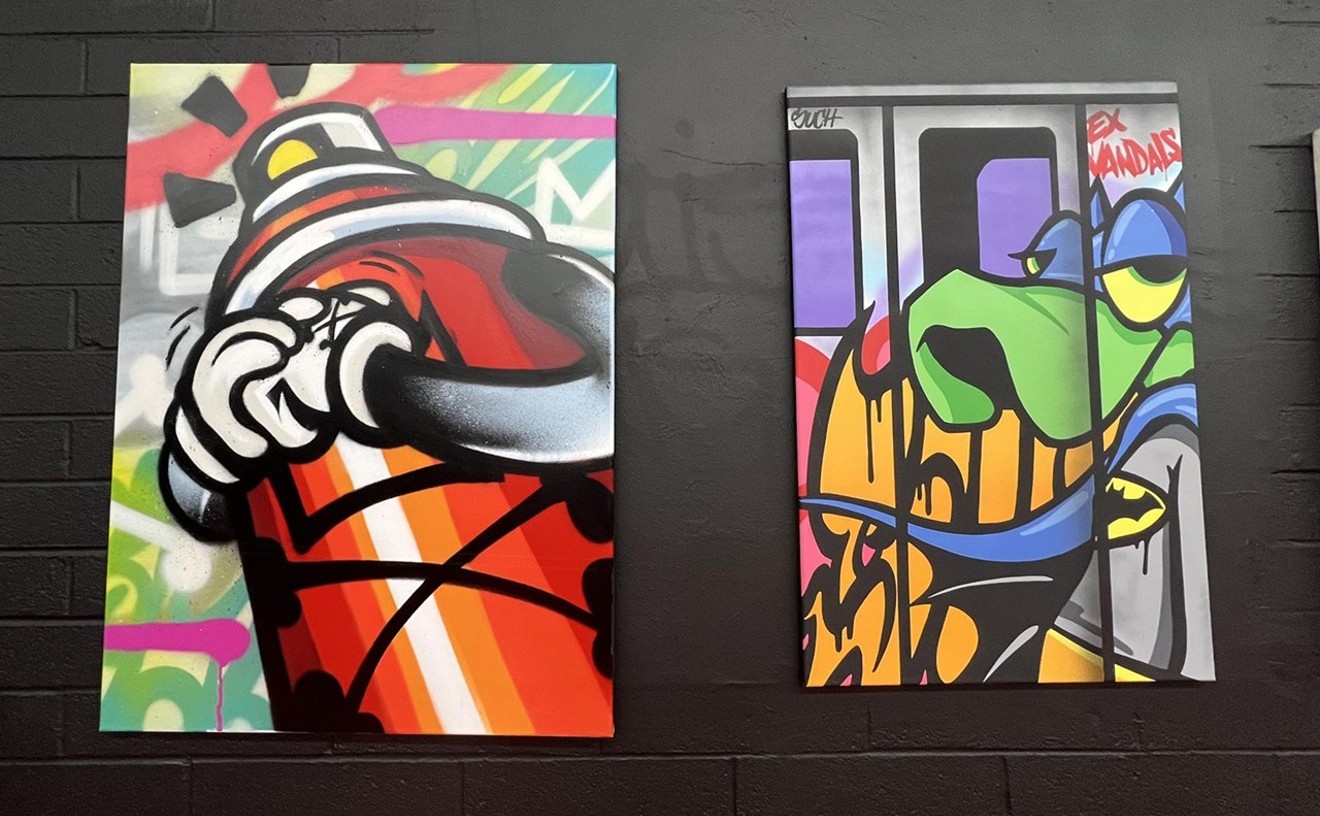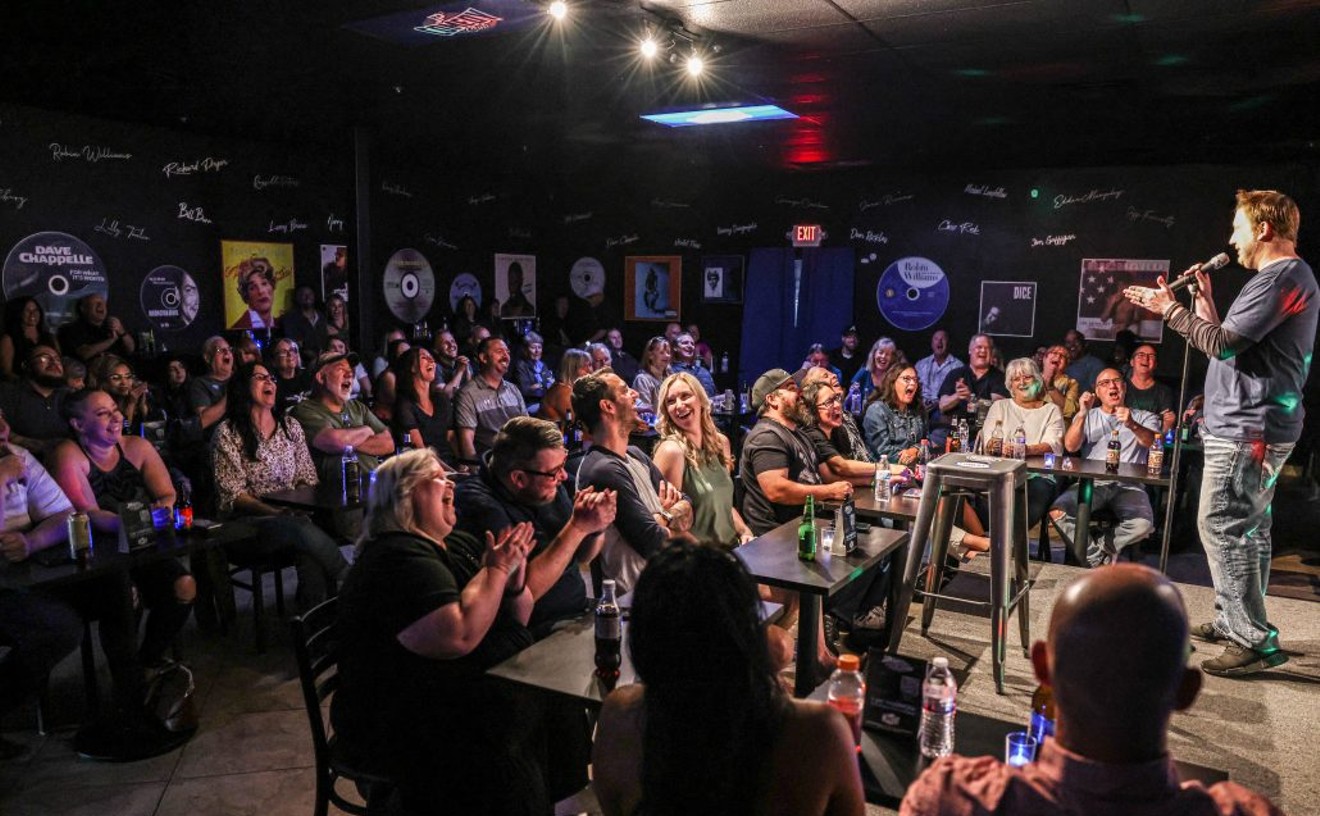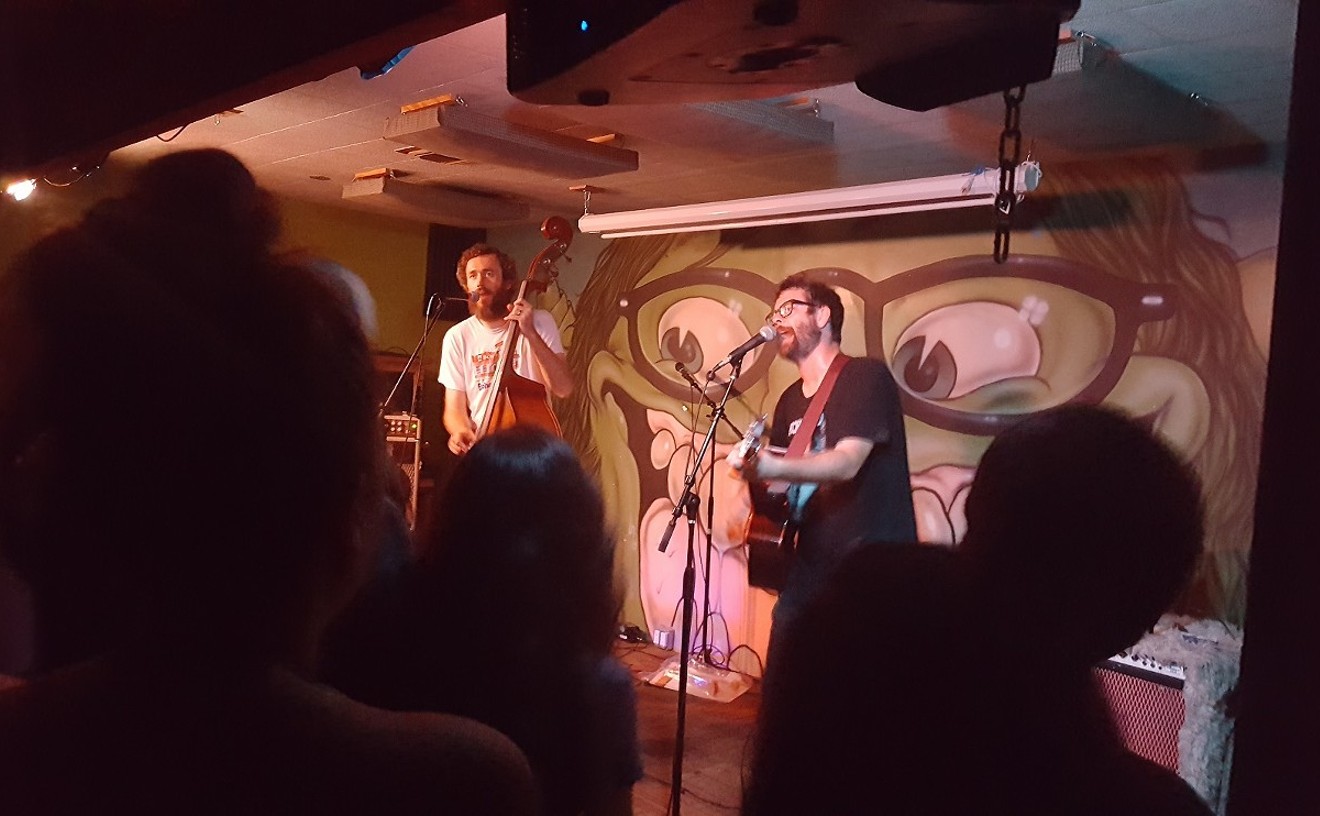Ellen Nemetz knows animals. The youngest of seven children, she grew up on a small dairy farm in rural Minnesota.
“I have always viewed animals as individuals,” Nemetz says by e-mail. For “Inquietude: A Humorous Take on Modern Anxieties,” Nemetz’s solo exhibition at Eye Lounge, the Phoenix-based artist paints realistic animals in unrealistic situations. She explains, “I chose animals to represent feelings of human anxiety because they allow me to express the [issues] in a less threatening manner.”
Thus, two buffalo stroll shamefully out of a barbershop with bad haircuts. A giraffe wearing a tie bends its neck to fit into a crowded elevator, which is already inhabited by an elephant with spectacles, an ostrich wearing a pearl necklace, and a Mallard duck with a bowtie. A similar group of animals attempts a misguided game of Twister; another crowds into a bubble bath. The animals poke their heads into the frames at odd angles, heads tilted, some squawking with closed eyes. Others stare straight at the viewers as if startled, or saying “Cheese!” for a photograph. Silly props abound, like wine glasses, rubber ducks, and snorkels.
The artist is careful not to make light of serious mental health issues. She is not commenting on disorders like OCD, agoraphobia, or PTSD, which can be debilitating. It is clear that Nemetz concerns herself with a less severe, more manageable “moderate social anxiety.” Nemetz defines “inquietude” as “that slightly uncomfortable feeling when you are in a large group, or when you are meeting strangers, or [that you feel] after meeting someone new.”
“I believe that social anxieties are far more prevalent today than they used to be,” Nemetz says, citing the rise of social media and its empty interactions as a contributing factor. “Preceding generations were too physically exhausted and involved with work and family to spend so much time being introspective about their interactions.”
Nemetz's subject matter — modern anxieties — is compelling. Unfortunately, her execution leaves something to be desired. If Nemetz is taking the "laughter is the best medicine" approach, the punchline of her joke is: "Look at these animals acting like nervous humans." The problem is — they aren't. They seem to be acting like animals; albeit, those who have been placed in unconventional settings.
The major limitation of Nemetz’s concept is that animals don’t display anxieties in their faces the way that we understand humans to. Thus, rather than appearing anxious or self-conscious, as the artist intends them to, the animals just look a bit startled.
Taken at face value, Nemetz’s paintings may appear juvenile. They’re wacky, zany, and absurd, like an episode of Doctor Dolittle or Mr. Ed. The gallery resembles a children's story book or a room-sized comic strip. With animals stuffed in elevators and bathtubs, these paintings teeter on the edge of kitsch. And kitsch is a tough genre to navigate. If it isn’t pushed to the extreme or subverted in some way, it runs the risk of getting its feet stuck in pure cheese-whiz.
That being said, the most effective painting in the show is Anomalous; the subjects, all rabbits (save for a nosey, eavesdropping goat), whisper into each other’s long fur-lined ears (which, like Gretchen Wieners’s hair, look as if they hold a lot of secrets). Perhaps it is easier to anthropomorphize rabbits after reading Watership Down, but the fact that they are engaged in a pose that is entirely human – raising their paws to cover their mouths as they whisper – immediately places the painting in another realm than the rest.
About the painting, Nemetz says, “It represents the feelings of not belonging." Considering the success of this model, Nemetz might wish to stick with one or two species of animals at a time. Her vast menagerie of colorful creatures certainly demonstrates her technical prowess as a painter, but perhaps at the expense of a general cohesiveness of story.
Furthermore, in choosing animals to replace humans as her subjects, Nemetz is poised to engage in an important conversation – a commentary on animal/human relationships. Many artists and scholars investigate the subtleties and politics of these relationships. (For example, the Icelandic and British artist duo Bryndís Snæbjörnsdóttir and Mark Wilson and American artist Mark Dion all visited the ASU Art Museum last year to speak at length about their work on endangered species.) Current issues range from vegetarianism and environmentalism to the ethical implications of animal experimentation, why we eat certain animals and not others, and how the level of demonstrable pain we can observe in an animal is directly tied to our empathy for it. (If you’re jonesing to fall down an internet rabbit hole, check out this in-depth linguistic analysis of human terminology for killing animals or Jacques Derrida’s excellent book The Animal That Therefore I Am.)
Nemetz's body of work seems stifled by the limitations of a gallery. It might do better to breathe in the world. A fresh context could inject life and add meaning to each of these images. Imagine, for instance, the implications that would follow if her painting “Global Warming” — in which chickens casually soak in a pot of boiling water like a jacuzzi – were to hang on the wall of a chicken and waffles restaurant. This way, the animals might maintain their “individuality," which Nemetz seemed to treasure in her youth, rather than being used as literary devices.
In the end, “Inquietude,” which is meant to be a humorous take on human modern social anxieties, cannot (and should not) divorce itself so easily from its non-human subjects.
“Inquietude: A Humorous Take on Modern Anxieties" runs through Saturday, December 12, at Eye Lounge: A Contemporary Art Space.
[
{
"name": "Air - MediumRectangle - Inline Content - Mobile Display Size",
"component": "18478561",
"insertPoint": "2",
"requiredCountToDisplay": "2"
},{
"name": "Editor Picks",
"component": "16759093",
"insertPoint": "4",
"requiredCountToDisplay": "1"
},{
"name": "Inline Links",
"component": "17980324",
"insertPoint": "8th",
"startingPoint": 8,
"requiredCountToDisplay": "7",
"maxInsertions": 25
},{
"name": "Air - MediumRectangle - Combo - Inline Content",
"component": "16759092",
"insertPoint": "8th",
"startingPoint": 8,
"requiredCountToDisplay": "7",
"maxInsertions": 25
},{
"name": "Inline Links",
"component": "17980324",
"insertPoint": "8th",
"startingPoint": 12,
"requiredCountToDisplay": "11",
"maxInsertions": 24
},{
"name": "Air - Leaderboard Tower - Combo - Inline Content",
"component": "16759094",
"insertPoint": "8th",
"startingPoint": 12,
"requiredCountToDisplay": "11",
"maxInsertions": 24
}
]










